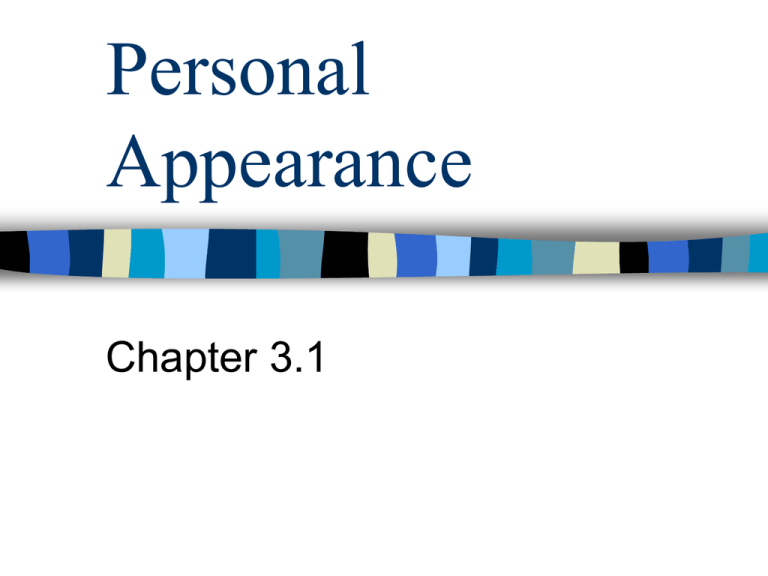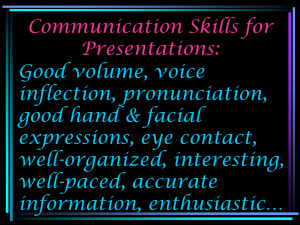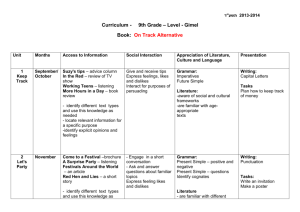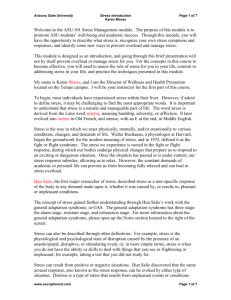HOC 1 - 3 Personal Appearance
advertisement

Personal Appearance Chapter 3.1 First Impressions Important to present an appearance that inspires confidence & a positive self image Within 20 seconds to 4 minutes, first impressions are made Rules for appearance vary with profession Professional standards apply to most health careers & should be observed to create a positive impression Good Health Involves promoting health & preventing disease Should have a healthy appearance Diet – well balanced meals Rest – provides energy & ability, amount varies from person to person Exercise – maintains circulation, muscle tone, helps attitude, helps sleep Good Health (cont) Good posture – prevents fatigue, decreases muscle strain. Demo standing & sitting Avoid tobacco & drugs – affects function of circulatory system, heart, & digestive system. Most facilities smoke-free Avoid alcohol – affects mental function & decreases good decision-making, affects many body systems. Can result in job loss Uniform May be required Clean, neat, well-fitting, wrinkle free White/neutral undergarments under white clothing Avoid extreme styles Find out what type & color of uniform is required, then follow standards established by employer Clothing May wear in place of uniform if allowed Clean, neat, good repair Style should allow for body movement Appropriate for position – jeans? Washable fabrics best Name tags Most facilities require use of name badge or photo identification States name, title, & department In some facilities, name badge is required by law Shoes White shoes often required Should fit & provide good support Low heels best Avoid tennis shoes & sandals Clean daily & replace shoelaces regularly Avoid colored or patterned stockings Personal hygiene Health worker is in close contact with others Control body odor – daily shower, deodorant use, good oral hygiene, clean undergarments Avoid strong odors – tobacco, perfume, scented hairsprays, aftershave lotion Certain scents can cause allergic reactions or nausea Fingernails Keep short & clean Long nails cause injury, puncture or tear gloves, transmit microorganisms Avoid colored polish – conceals dirt, polish chips off, flash of colors can bother an ill person If wearing polish, should be colorless Use hand lotion to prevent chapping & dryness caused by frequent handwashing Hair Clean & neat Avoid fancy or extreme styles or ornaments Pinned back & off of collar – prevents hair from touching pt, falling on trays or equipment, avoids blocking vision during a procedure Jewelry Usually not permitted with uniform Can cause injury to pt & transmit pathogens Can wear watch, wedding band, & small pierced earrings – NO hoops or dangling earrings Body jewelry (nose, eyebrow, tongue, lip rings) detracts from professional appearance & is prohibited at many facilities Make-up Avoid excessive make-up Should create natural appearance & add to attractiveness Personal Characteristics Chapter 3.2 Characteristics of a health care worker Empathy – ability to identify with & understand another person’s feelings, situation, & motives. – Must have sincere interest in working with people – Must care about & be able to communicate – Understand needs & learn effective communication skills Characteristics of a health care worker Honesty – truthfulness & integrity – Must be able to trust you at all times – Willing to admit mistakes so they can be corrected Dependability – accept the responsibility required by your position – Prompt in reporting to work, good attendance record – Perform assigned tasks on time & accurately Characteristics of a health care worker Willingness to learn – willing to learn new things & adapt to change – Due to research, new inventions, tech – Learning new techniques or getting additional education – Lifelong learning required Patience – tolerant & understanding – Control your temper, count to 10 – Deal with frustration & overcome obstacles Characteristics of a health care worker Acceptance of criticism – willing to accept criticism & learn from it – Pts, employers, co-workers, families – Some is constructive – allows you to improve your work – Everyone can improve performance Enthusiasm – must enjoy your work & have a positive attitude – Enthusiasm is contagious, helps you do your best & encourages others to do the same – Concentrate on positive points so that negatives are not so important Characteristics of a health care worker Self motivation – ability to begin or follow through with a task – Should be able to determine what needs to be done & do them without constant direction – Set goals & work to reach them Tact – ability to say or do the kindest or most fitting thing in a difficult situation – Everyone has a right to feelings & should not be judged as right or wrong – Shows consideration for the feelings of others – Requires constant practice Characteristics of health care workers Competence – qualified & capable of performing a task – Follow instructions, use approved procedures – Strive for accuracy & know your limits – Ask for help if necessary Responsibility – willing to be held accountable for your actions – Others rely on you, you will meet expectations – Do what you are supposed to do Characteristics of health care workers Discretion – using good judgment in what you say & do – Confidential information – Need proper authorization to get info – Be discreet, ensure that pt’s rights are not violated Team player – learn to work well with others – Each member of the team has different responsibilities, but each must do his part – Working together accomplishes the goal faster Characteristics of health care workers All characteristics must be practiced & learned Some take more time to develop than others Be aware of these characteristics & strive to improve If practiced, you will be a valuable asset to your employer Teamwork Chapter 3.3 Teamwork Part of an interdisciplinary health care team Provides quality holistic care Consists of many professionals, with different educations, backgrounds, ideas, & interests working together for the good of the pt. What professionals might be involved in the care of a surgical pt? Each team member has an important job to do Team working together = quality care given Teamwork Improves communication & continuity of care – Pt knows the caregivers & support staff – All team members help identify needs, offer opinions, participate in decision making, & suggest others to help – Allows a pt to become more educated about options & make informed decisions Teamwork Every person must understand the team member’s individual roles – Knowledge provides a picture of the total care plan – Helps clarify responsibility & establishes goals – Most teams have frequent PATIENT CARE CONFERENCES – Pt may be an active participant Leader Important member of the team Responsible for: – Organizing/coordinating activities – Encouraging new ideas & opinions – Motivating members to work towards goals – Assisting with problems – Monitoring progress – Providing reports & feedback Good interpersonal relationships Quality of care harmed by poor interpersonal relationships between team members Team members have different cultural & ethnic backgrounds, BE SENSITIVE Treat others as you would want to be treated Good interpersonal relationships Include: – – – – – – – – – Maintaining positive attitude & laughing at yourself Being friendly & cooperative Assisting others when they need help Listening carefully to other’s ideas Respecting the opinions of others Being open-minded & willing to compromise Avoiding criticism of other team members Learning good communication skills Performing your duties to the best of your ability Legal responsibilities All members of the team must function within legal boundaries No team member should ever try to solve a problem or perform a duty that is beyond the range of duties permitted Effective teamwork results from hard work, patience, communication, & practice. When every individual participates fully in the team, the team achieves success Professional leadership Chapter 3.4 Leadership Definition – the skill or ability to encourage people to work together & do their best to achieve common goals Leader = One who leads or guides others, one who is in charge or in command of others Leaders are NOT born, they are developed by their own efforts – Combine visions of excellence with the ability to inspire others – Anyone can be a leader – Promote positive changes that benefit profession – Every contributing member can be a leader Characteristics of a leader All characteristics can be learned Respect rights, dignity, opinions, & ability of others Understands democratic principles Works with a group to guide toward goal Understands own strengths/weakness Self-confident & willing to take a stand Communicates effectively Self-initiative, willing to work, completes tasks, optimistic, open-minded, compromises Praises others & gives credit Categories of leaders Religious, political, club, organization, business, community, experts, & peers Leaders develop based on involvement Any individual that joins an organization can become a leader Types of leaders DEMOCRATIC – Encourages participation of all people in decision-making or problem solving – Listens to others’ opinions & bases decisions on what is best for the group – Guides individuals to a solution so the groups can take responsibility for the decision Types of leaders LAISSEZ-FAIRE – Informal leader that strives for minimal rules & regs – Allows individuals to function independently – Hands off policy, makes decisions only when forced to – Laissez-faire means “to let alone” Types of leaders AUTOCRATIC – Often called dictator – Maintains total rule, makes all decisions, has difficulty delegating or sharing duties – Seldom asks others’ opinions, emphasizes discipline, expects others to follow direction at all times – Individuals follow this leader out of fear of punishment or extreme loyalty Leadership All types of leadership have advantages & disadvantages Rarely, autocratic leader may be beneficial Democratic leader is usually most effective Remember to respect the rights & opinions of others for effective leadership Stress & Time Management Chapter 3.5 – 3.6 Stress Definition – the body’s reaction to any stimulus that requires a person to adjust to a changing environment – Change always initiates stress, even if it is good Stressors – stimuli to change, alter behavior, or adapt to a situation – Can be situations, events, or concepts – External vs. internal forces • External – new job • Internal – heart attack Stressors cause Body goes into an alarm mode – Called flight or fight response – Sympathetic nervous system works OT • • • • • • Adrenaline released (hormone from adrenals) Blood vessels to heart & brain dilate Blood vessels to skin & internal organs constrict Pupils in eye dilate Saliva decreases Heart beats faster, blood pressure rises, respiratory rate increases • Actions provide body with burst of energy & stamina required to respond to stressor After the stress is over Parasympathetic nervous system works – Opposite reactions cause fatigue or exhaustion while body recovers – If body is subjected to constant stress, normal body functions are disrupted – Can result in serious illness or disease – Migraine headaches, anxiety reactions, depression, allergies, asthma, digestive disorders, hypertension, insomnia, heart disease Stress Everyone experiences Amount of stress depends on the individual reaction to & perception of the situation – Example – blood test can be stressful for some, but routine for another Causes of stress Relationships Job or school Foods – caffeine, salt, sweets Illness & lifestyle Finances Family events – birth, death, marriage, divorce Overwork, boredom, negative feelings Time limitations – too much to do Failure to achieve goals Response to stressors If stress causes positive feelings, it can be helpful (achievement, excitement, anticipation, etc) If stress causes negative feelings, it can be harmful (boredom, frustration, irritability, anger, depression, distrust, self-criticism, exhaustion) Negative Stress Can lead to substance abuse – Smoking, alcohol use, drug use, excessive eating – Trying to find comfort & escape from negative feelings Can lead to mental breakdown Be aware of stressors & learn to control them Steps to control stress Identify stressors – Awareness of stressor & how you deal with it, can you change it? Solve or eliminate the problem – Gather info, assess situation, identify problem, list possible solutions, make a plan, act on solution, evaluate results, change solution if necessary Managing stress STOP – immediately stop to break out of stress response BREATHE – slow deep breath to relieve tension REFLECT – think about the problem & cause of stress CHOOSE – decide how you want to deal with the stress Stress-reducing techniques Live a healthy life – diet, exercise, rest Take a break from stressors Take a warm bath Escape to quiet music or book Relieve tension – slow deep breaths Rely on others – talk to a friend Meditate & use imagery Enjoy yourself & Renew yourself Think positively Develop outside interests Seek assistance & delegate, say NO Remember Stress is a constant presence & cannot be avoided Be aware of causes & learn how to respond when a stress reaction occurs Solve problems effectively Practice techniques to reduce the effect of stress Patients also can experience stress as they deal with their illness Time Management Definition – a system of practical skills that allow a person to use time in the most efficient & productive way possible Helps prevent or reduce stress – – – – – – Puts individual in charge Keeps things in perspective Increases productivity Uses time effectively Improves enjoyment of activities Provides time for relaxing & enjoying life Steps of time management Keep an activity record for several days – Determines how you use time – Activities that are performed, amount of time they take, how effective activity was – Wasted time obvious Now begin to organize time – Schedule important projects – Work when feel energetic, rest when feel fatigued Set goals to help you find your direction – Short term & long term Set effective goals – accomplish not avoid – Prioritize & make sure goals are attainable Steps of time management Accomplish goals – Organize steps to help you accomplish – If goal achieved – enjoy accomplishment – If goal not achieved – evaluate & determine why you failed • • • • Unrealistic goal? Lack skills or knowledge? Another way to accomplish? Failure can be positive Time Management to meet goals Analyze & prioritize – Review goals, list tasks to accomplish them most important to least important – Delegate if necessary Identify habits & preferences – Energy high vs energy low Schedule tasks, make lists Plan your work – pace yourself Avoid distractions – screen calls, say no Take credit for job well done Time management Provides for organized & efficient use of time Things do not always go according to plan, even with careful planning Common events – emergencies, new assignments, complications, overscheduling Determine the reason for failure if time management doesn’t work Reevaluate goals & revise plan Patience, practice, & an honest effort necessary for success







